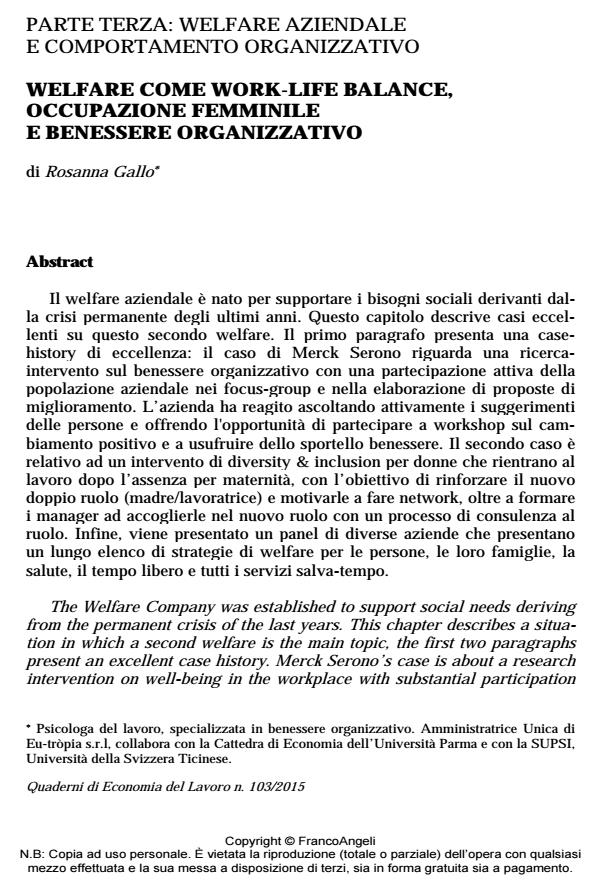Parte terza: welfare aziendale e comportamento organizzativo. Welfare come work-life balance, occupazione femminile e benessere organizzativo
Journal title QUADERNI DI ECONOMIA DEL LAVORO
Author/s Rosanna Gallo
Publishing Year 2015 Issue 2015/103 Language Italian
Pages 31 P. 285-315 File size 142 KB
DOI 10.3280/QUA2015-103013
DOI is like a bar code for intellectual property: to have more infomation
click here
Below, you can see the article first page
If you want to buy this article in PDF format, you can do it, following the instructions to buy download credits

FrancoAngeli is member of Publishers International Linking Association, Inc (PILA), a not-for-profit association which run the CrossRef service enabling links to and from online scholarly content.
The Welfare Company was established to support social needs deriving from the permanent crisis of the last years. This chapter describes a situation in which a second welfare is the main topic, the first two paragraphs present an excellent case history. Merck Serono’s case is about a research intervention on well-being in the workplace with substantial participation from people acting in focus-groups and making proposals. The company reacted by listening closely to people’s suggestions and offered the opportunity to participate in a workshop on positive change and a well-being help desk. The second case history is about a diversity intervention for women returning from maternity leave, in order to reinforce the new double role (mother/worker) and to motivate a network and train managers to welcome them through a role consultancy process. Lastly, there is a panel of different companies presenting a large list of welfare strategies for people, including families, as well as wealth, free time and time-saving services.
- Greenhaus J.H. e Beutell N. (1985). Sources of conflicts between work and family roles. Academy of Management Review, 10: 76-88.
- Burke R.J. (1988). Some antecedents and consequences of work-family conflict. Journal of Social Behavior and Personality, 3: 287–302.
- Crouter A.C. (1984). Spillover from family to work: The neglected side of the work-family interface. Human Relations, 37: 425-441.
- Evans P. e Bartolome F. (1986). The dynamics of work-family relationships in managerial lives. International Review of Applied Psychology, 35: 371-395.
- Greenhaus J.H. e Powell G.N. (2006). When work and family are allies: a theory of work-family enrichment. Academy of Management Review, 31(1): 72-92.
- ISTAT (2013). Il benessere equo e sostenibile in Italia. Roma: ISTAT.
- ISTAT (2012). La soddisfazione dei cittadini per le condizioni di vita. Roma: ISTAT. (Statistiche Report, 15 novembre). www.istat.it/it/archivio/74482/
- Kreitner R. e Kinicki A. (2004). Comportamento organizzativo. Milano: Apogeo.
- Lambert S.J. (1990). Processes linking work and family: A critical review and research agenda. Human Relations, 43: 239-257.
- Livraghi R. (2008) I diversi bisogni di flessibilità. Aggiornamenti sociali, aprile.
- Payton-Miyazaki M. e Brayfield A.H. (1976). The good job and the good life: Relationship of characteristics of employment to general well-being. In: Biderman A.D. e Drury T.F., editors, Measuring work quality for social reporting. New York: Sage.
- Piotrkowski C.S. (1979). Work and the family system. New York: Free Press.
- Pleck J.H. (1977). The work-family role system. Social Problems, 24: 417–427.
- Staines G.L. (1980). Spillover versus compensation: A review of the literature on the relationship between work and nonwork. Human Relations, 33: 111-129.
- Sieber S.D. (1974). Toward a Theory of Role Accumulation. American Sociological Rewiew: 567-578.
- Penn State e Akron (studio su 2.540 donne diventate madri tra il 1978 e il 1995).
Rosanna Gallo, Parte terza: welfare aziendale e comportamento organizzativo. Welfare come work-life balance, occupazione femminile e benessere organizzativo in "QUADERNI DI ECONOMIA DEL LAVORO" 103/2015, pp 285-315, DOI: 10.3280/QUA2015-103013